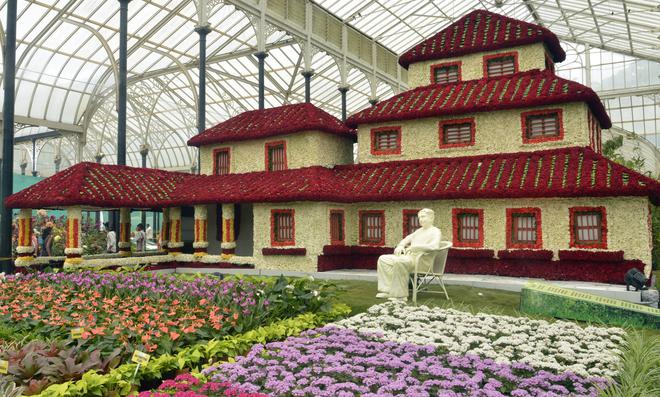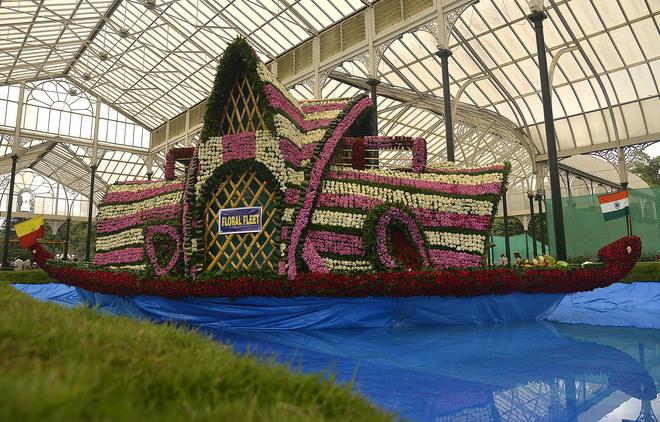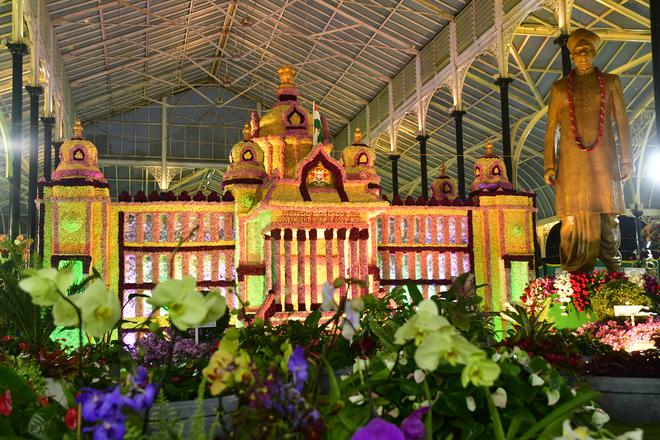It’s that time of the year again when colourful blooms attract people to Bengaluru. Independence Day is here, and Bengaluru’s Lalbagh is presenting its 214th flower show, which this year is designed as a tribute to Karnataka’s second Chief Minister Kengal Hanumanthaiah.
The Independence Day flower show, which was inaugurated on August 4, witnessed a footfall of close to one lakh people from across the country in the first two days of its opening. As a floral tribute to Hanumanthaiya, a 14-feet statue of the former Chief Minister, an 18-feet replica of the Vidhana Soudha, and a replica of the Shivapura Satyagraha Soudha are among the attractions this year.
While it is common knowledge that Lalbagh hosts two flower shows every year, what is less known is the history of the flower show itself, which started way back in 1867. When the Agri-Horticulture Society of India was started in 1820, various programmes and exhibitions were put up by farmers and plantation growers. As part of this exhibition, in February 1867, a two-day flower show by many florists, fruit growers, and cattlemen emerged, wherein the best presenters were awarded.
The early seasonal shows
The flower show has been a biannual event for many years, initially presented only during the summer and winter seasons. However, in 1951, it was declared that biannual flower shows would be celebrated during the two national festivals, Republic Day and Independence Day.

In the book Bangalore’s Lalbagh a Chronicle of the Garden and the City, author Suresh Jayaram says that the flower shows were a tradition established by the garden’s superintendents and initially happened at the Bandstand. Speaking to The Hindu, Suresh Jayaram said, “The initial flower shows were held in and around the Bandstand and the venue was changed to the Glass House since its construction in 1891. These popular shows were held as part of the Agri-Horticultural Society’s vision to promote horticulture in the region.”
Animals add variety
The book also says that prizes were given across categories such as best foliage, perennials, annuals, cut flowers, and English fruits, categories which were strictly adhered to. A primary requirement was that all exhibits had to be grown locally in the then Mysore State. In a bid to add variety to the flower shows, exhibitions in 1869 and 1870 included livestock-cattle, sheep, poultry, and displays of horses of Mysore pedigree.

John Cameron, who took over as the Superintendent of Lalbagh in March 1874, initiated the establishment of the Glass House, which later became the venue for the flower shows. It is said that the structure of the Glass House was inspired by the giant Crystal Palace in London. John Cameron holds the esteemed title of the ‘Father of Horticulture’ in Karnataka.
With a specialization in botany and training from the Royal Botanical Garden, Kew, London, upon his arrival in India, he assumed the role of Curator at the Lalbagh Botanical Gardens. Taking on this responsibility as a challenge, he dedicated his efforts to enhancing the prominence of horticulture in the former kingdom of Mysore.
Krumbiegel’s big role
Gustav Hermann Krumbiegel is another significant figure in Bengaluru’s iconic flower show history. Appointed as the Superintendent of Lalbagh in 1908, he transformed the flower show into a regular and immensely popular event. He likely drew inspiration from London’s Chelsea Flower Show, a prominent occasion in British high society.

According to Suresh Jayaram’s book, in 1912, Krumbiegel had also introduced a floral bicycle parade in which young girls, including his own daughter Hilda, dressed in all their finery, cycled around with flower-bedecked bicycles. A horticulture and landscape architecture specialist, he began his career at the Royal Botanical Gardens in Kew, London, before becoming the curator of Botanical Gardens in Baroda, a former princely state in India. To enhance the reputation of Lalbagh, Krumbiegel orchestrated the introduction of numerous exotic floral species through international correspondence and contacts.
Today the road between the main and the west gates of Lalbagh is named Krumbiegel Road in honour of the German botanist who was buried in Bengaluru on his death in 1956.







